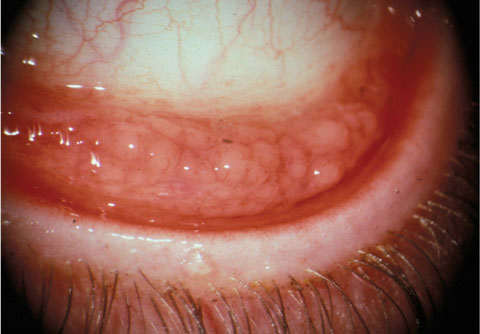 |
| Experts differ on whether or not use of antibiotics is worthwhile in chlamydial conjunctivitis. Photo: Marc Bloomenstein, OD. Click image to enlarge. |
Noninfectious and infectious conjunctivitis symptoms are major drivers in those seeking eye care. Given that the prevalence of ocular allergy is increasing globally, public health experts anticipate a greater need for eye care interventions. Researchers in Belfast conducted a systematic literature review of clinical practice guidelines (CPGs) relating to infectious and noninfectious conjunctivitis and found a number of high-quality CPGs in agreement with each other. They reported that inconsistencies mainly related to the scope of practice of the targeted end-user of a particular guideline.
The researchers reviewed and evaluated CPGs published between 2010 and 2020. Data were independently extracted and evaluated using standardized forms. A total of 15 CPGs from five sources met the inclusion criteria. The researchers noted that the methods used to assess the level of evidence and strength of the recommendation varied among the CPGs. Their findings are summarized in the table.
“Comparing recommendations for a specific eye condition across CPGs wasn’t possible due to the differences of guideline intended users,” the researchers explained. “The end-users for NICE, COO and USPSTF guidelines were mainly primary care personnel; AAO was developed for ophthalmologists, while DECA for primary and secondary care practitioners. Interventions beyond primary care weren’t comprehensively included in NICE and COO guidelines.”
One example of end-user variability was the recommendation of antibacterial medication for chlamydial conjunctivitis by the AAO but not the COO guidelines. “We found that these interventions were instead categorized as possible management by ophthalmologists with no level of evidence and strength of recommendation reported,” they noted. “This categorization was possibly due to the [fact that] end-users for COO were mainly practicing at the primary level, and conditions such as chlamydial infection will typically be referred to ophthalmological care for further investigation and management. This was similar to noninfectious conjunctivitis, in which immunotherapy wasn’t included as management in NICE and COO guidelines but appeared in AAO and DECA.”
The inconsistencies among some CPGs, in terms of the level of evidence and recommendation strength, strongly imply that further standardization is needed, say the researchers. “The AAO guideline rated the level of evidence as good and strongly recommended topical antihistamine (second generation) or a combination of antihistamine and vasoconstrictor for management of mild allergic conjunctivitis,” the researchers noted. “However, COO rated the evidence for topical antihistamine to manage mild allergic conjunctivitis as low, although strong recommendation was reported.”
“The COO graded evidence as high and strongly recommended prescribing systemic antihistamine in managing seasonal allergic conjunctivitis (SAC) and perennial allergic conjunctivitis (PAC),” they continued. “In contrast, AAO reported that the adverse effect from systemic antihistamine (drying of the ocular surface) may worsen the condition of allergic conjunctivitis and didn’t include it as a recommendation. In AAO, the use of a combination of antihistamine and vasoconstrictor was strongly recommended for mild SAC or PAC, while in NICE, this intervention was recommended only for allergies that nonpharmacological interventions cannot resolve.”
The researchers suggest that the lack of consistency may be due to a lack of high-quality evidence supporting nonpharmacological interventions. “CPG development groups tend to omit these interventions,” the researchers pointed out. “We suggest that a more robust research methodology could be employed in testing these interventions in future research.” They added that development groups should adhere to a standard protocol or guide to ensure high-quality guidelines.
Chan V, Yong A, Azuara-Blanco A, et al. A systematic review of clinical practice guidelines for infectious and non-infectious conjunctivitis. Ophthalmic Epidemiol. August 29, 2021. [Epub ahead of print]. |

